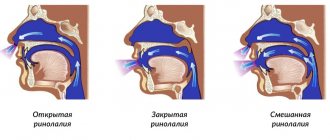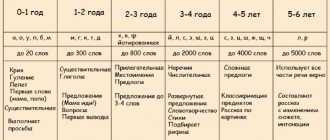Rhinolalia is a speech disorder that occurs due to the structural features of the nasopharynx. The defect characterizes distortion of voice timbre, decreased speech intelligibility, and replacement of sounds. The disorder is corrected with medication, and regular sessions with a speech therapist and specialized exercises are also required.
Kinds
Types of nasality:
- closed;
- open;
- mixed.
Closed nasality is the result of poor nasal obstruction and is called rhinophony or palatophonia. Open nasality is called nasality, in which sounds pass not only through the mouth, but also through the nasal passage.
In the mixed form, there is nasal obstruction and a weakened velopharyngeal seal.
Causes
The most common causes of a nasal voice are:
- poor mobility of the soft palate;
- incorrect form of the tongue during pronunciation;
- existing defects of the hard or soft palate.
Diseases that are accompanied by rhinolalia:
- nasopharyngeal tumor;
- hypertrophy and swelling of the nasal concha;
- pathological enlargement of the nasopharyngeal tonsils (adenoids);
- the appearance of mucus in the nasal cavity (runny nose);
- congenital curvature of the nasal septum;
- the habit of incorrectly pronouncing words due to a hearing defect (deafness);
- tertiary syphilis;
- various injuries.
Diagnostics
Nasality can be diagnosed independently. To do this, close your mouth tightly and try to hum a melody. If you feel puffs of air coming from your lips, then rhinolalia is not a threat to you. Another way to check is to say all the letters of the alphabet, except “m” and “n”, with your nose pinched.
If you notice the first signs of nasality, consult a doctor immediately. Depending on the symptoms and external examination, he will prescribe the necessary comprehensive examination and tests. When examined by a speech therapist, the structure and functioning of the speech apparatus is studied, and the quality of breathing is checked during a conversation.
For open rhinolalia, the Gutzmann method is used, the essence of which is to pronounce the vowel sounds “a” and “i” with alternate closing and opening of the nasal passages. Then the pronunciation of all other vowel sounds is examined.
Determining the cause of nasality depends on the following factors:
- duration of the disease;
- nature of sound defects;
- past and chronic diseases.
It is often very difficult to identify the true cause of nasality; here it is necessary to consult with a number of specialists: a surgeon, phoniologist, endocrinologist, neurologist or speech therapist.
The most common types of examination are radiography of the nasopharynx, pharyngoscopy and electromyography. If necessary, you need to undergo a general and detailed blood and urine test.
1.General information
Such a well-known phenomenon as nasality, only at the level of ordinary consciousness or pseudo-medical practices may seem self-evident, simple, and does not require special explanation. In reality, this complex acoustic phenomenon is caused by pathological changes in the unique phonation-articulatory (speech-sound) apparatus of a person, which can arise under the influence of many reasons and take a number of significantly different clinical forms.
It should be noted that the scope and content of the very concept of “nasal”, as well as the terminology used in texts devoted to this phenomenon, differ depending on which medical specialty the publication relates to - phoniatry, speech therapy, pediatric or general otorhinolaryngology, ENT -surgery, etc. In particular, such terms as rhinolalia (“nasal speech”), rhinophonia (“nasal sound”), palatophonia/lalia (palatal sound/speech) are used with slightly different meanings. In English-language literature one can also find the expression “hypernasal speech”, equivalent to the Russian “speak through the nose”, etc.
In general, nasal voice and/or speech is a serious problem that impairs social functioning, reduces quality of life and, even in moderate severity, precludes suitability for a number of professions. Eliminating this violation is usually quite difficult; it requires time and significant effort, incl. from the patient himself.
A must read! Help with treatment and hospitalization!
Treatment
Treatment for nasality depends on the disease that causes it.
If the nasal tone is caused by a runny nose and nasal congestion, then you can use nasal drops or sprays: Nazivin, Galazolin, Sanorin, Tizin, Otrivin, etc.
If the cause is more serious, serious surgical intervention may be required: elimination of an anatomical defect, installation of a pharyngeal arbitrator, surgical correction of nasopharyngeal deformity.
If necessary, polyps, adenoids and tumors are removed. After the operation, it is necessary to massage the scars of the palate and monitor the correct velopharyngeal closure.
Additionally, physiotherapy, psychotherapy and long-term treatment with a speech therapist are used. The surgeon only eliminates the cause of the nasal sound, but only a speech therapist can teach the correct pronunciation of sounds.
Classes with a speech therapist for the treatment of nasality include articulation and breathing exercises, speech therapy massage of the soft and hard palate and correct pronunciation and production of sounds.
Exercise
For open and closed rhinolalia, you should perform articulation exercises for the tongue:
- The tongue needs to be pulled down to the chin and fixed in this way for 5-10 seconds.
- Vibrate with your tongue out from one corner of your mouth to the other.
- Open your mouth wide, stick out your tongue and rotate in a circle, imitating the hands of a clock.
The second set of exercises for the treatment of nasality:
- Exercise according to Emelyanov’s method. Pronounce the vowels in the following order: "ooaee". When you hear the sound “y”, make a good yawn.
- Sing vocal exercises and your favorite songs using the sounds “u”, “o”, “yu”.
- "Yawn." Make yawning movements several times. This exercise is very effective for proper breathing.
- The sounds "mu" and "nu". Say these words slowly, separating the letters: “m, u, n, u.”
- Drink water in very small sips. This stimulates the uvula to rise and tighten.
With an open nasal tone, it is very important to learn how to breathe correctly . To do this, you need to perform simple exercises: blowing out your cheeks, blowing soap bubbles, imitating blowing out a fire.
When eliminating nasality, the patient must be taught to speak abruptly, very clearly, slowly, with his mouth wide open. It is important to be able to distinguish the correct pronunciation of sounds from the incorrect one.
If a child has a nasal voice, regular massage of the soft palate will be very useful. Its goal is to stimulate the mobility of the palate and activate its movement.
If the child is small, parents should do the massage:
- Using a clean pad of the index finger of the right hand, the border between the hard and soft palate is rubbed to stimulate a reflex contraction of the muscles of the nasopharynx.
- Repeat this action when the child pronounces the letter “a”.
- Perform zigzag exercises from the left edge of the palate to the right and in the opposite direction.
- The index finger makes light pressing and pushing movements of the soft palate.
Massage should not be performed immediately after eating, as it can cause a gag reflex.
Treatment of nasality in children must be carried out carefully and in a timely manner; in advanced forms, speech defects can cause isolation, nervousness and even anger in the child.
Usually, nasal speech requires long-term treatment and great effort on the part of both the speech therapist and the parents.
Nasality is open
Some illnesses can cause voice distortion. We begin to pronounce certain sounds unintelligibly, “in the nose,” or, in other words, nasally.
Nasality is a distortion of pronounced sounds as a result of disruption of the normal participation of the nasal cavity in the speech process. In medicine, there is a term for this condition - rhinolalia.
As already mentioned, the nasal cavity is a direct participant in the process of formation of sounds and voice. For normal sound, the nasal cavity must be free, and air flows from the nasopharynx enter it to a minimum.
The movement of air flow is regulated by the uvula, which can be seen in the mirror if you open your mouth wide. Normally, the uvula is adjacent to the back wall of the pharynx, as if separating the oropharynx from the nasopharynx. If for some reason the uvula is in a relaxed state, nothing prevents air from the nasopharynx from entering the nasal cavity, and “nasal sounds” arise. If the tongue, on the contrary, is tense, air cannot pass through the nose at all and all sounds are formed only through the mouth, that is, the nasal cavity generally falls out of the process of sound formation. In both cases, nasality occurs.
There are two types of nasality: closed and open. Closed nasality occurs when air cannot pass freely through the nasal cavity (for example, with a chronic runny nose or enlarged adenoids).
With open nasality, too much air enters the nasal cavity, speech becomes slurred, and the person begins to speak “into the nose.” Vowel sounds acquire a pronounced nasal connotation. It happens that the pronunciation of consonant sounds is greatly deformed. In this case, it becomes extremely difficult to understand what the person is talking about.
Friends! Timely and correct treatment will ensure you a speedy recovery!
Open nasality manifests itself in the following pathological conditions:
- cleft palate;
- deformations of the hard and soft palate;
- shortening of the soft palate;
- paralysis of the palate.
If you notice the first signs of rhinolalia, please consult a doctor. After the diagnosis, the cause that led to nasality will be identified, and treatment will be prescribed. It is often necessary to consult several doctors at once: a speech therapist, a neurologist, a surgeon and others.
Make an appointment right now!
Call us by phone or use the feedback form
Sign up
Treatment for open nasal sounds usually involves surgery to eliminate defects in the palate. For paralysis of the palate, massage and physiotherapeutic procedures are indicated. At the same time, it is necessary to conduct classes with a speech therapist. Usually, a combination of surgical and speech therapy methods brings a good positive effect.
Prevention
To prevent the appearance of nasality and further complications, the following recommendations must be followed:
- monitor the condition of the nasopharynx; if there is the slightest change, you should consult a doctor;
- avoid colds and viral diseases;
- pay attention to how you pronounce individual sounds and words;
- if surgical intervention is necessary, do not delay, otherwise the consequences of such a delay can be very serious for health;
- Avoid hypothermia and maintain a proper daily routine.
MANIFESTATION
The degree of manifestation depends on the severity of the disease. There are 4 degrees. At the first level, the timbre of the voice changes, and the intelligibility of speech is slightly impaired. The next degree is characterized by a large number of violations, individual sounds are replaced, and the intelligibility of what is spoken is lost. The third degree demonstrates an increase in symptoms, but speech remains understandable, although it has a number of distortions. The fourth degree is characterized by severe distortion of speech, phrases become incomprehensible to others.










